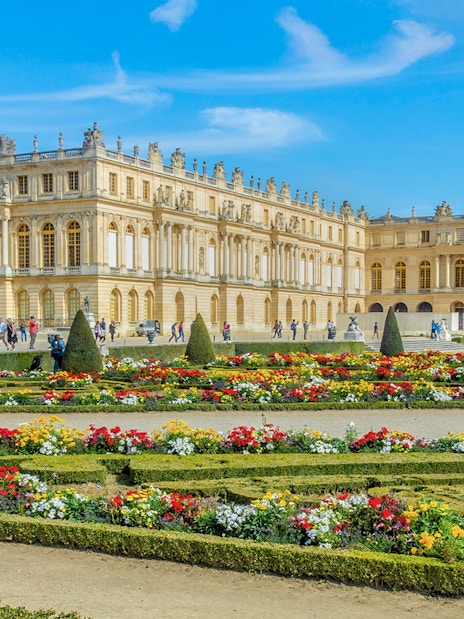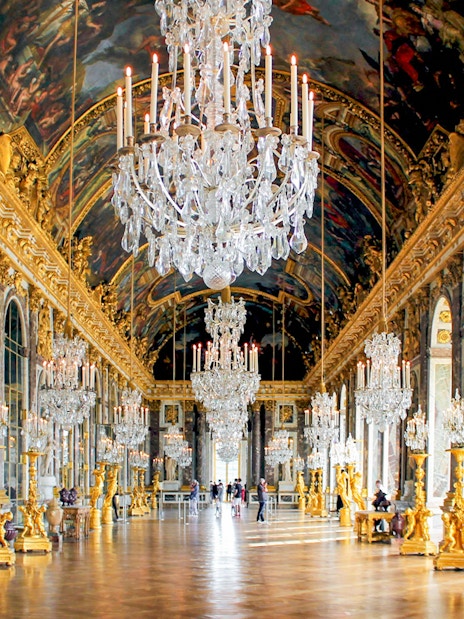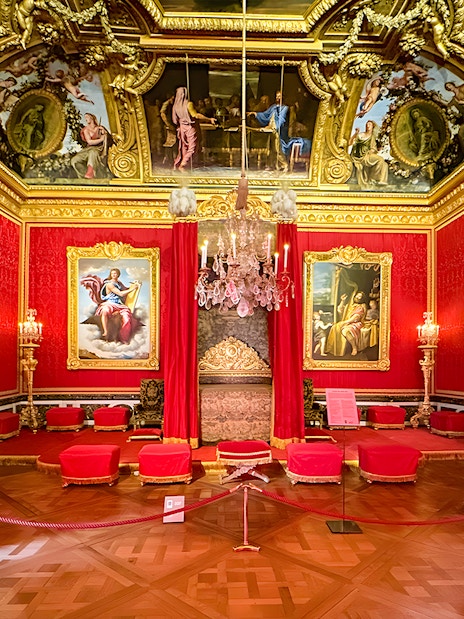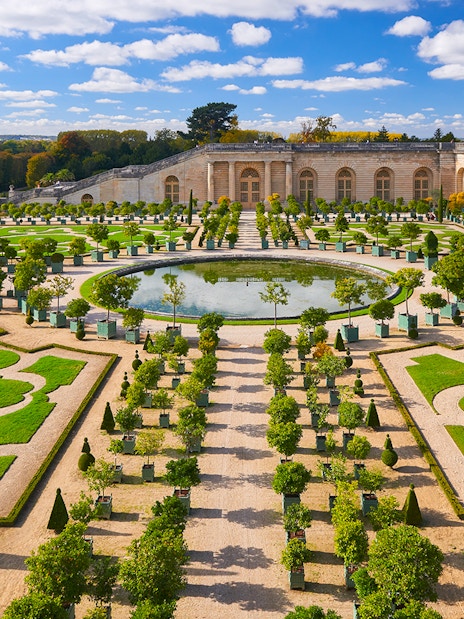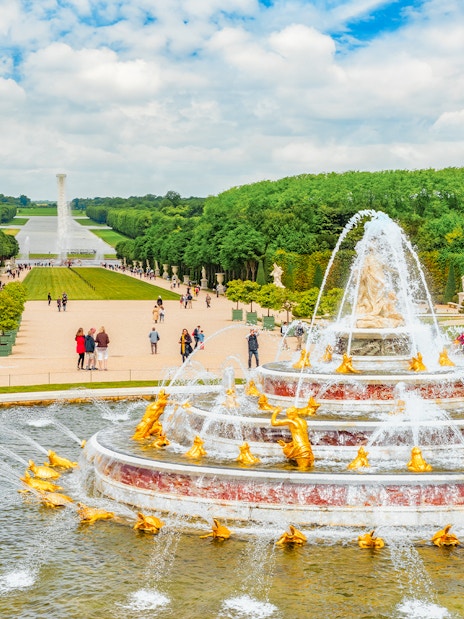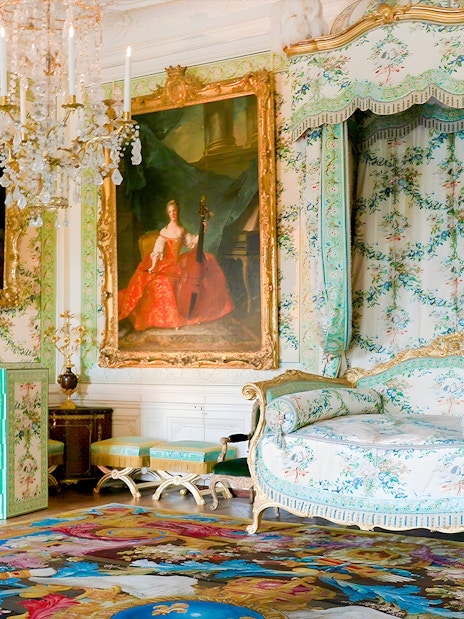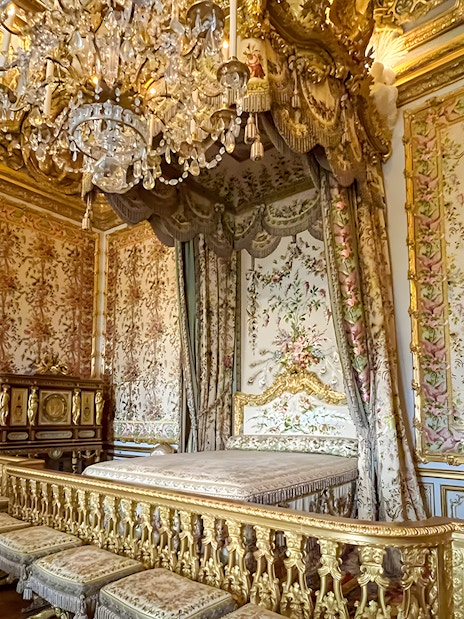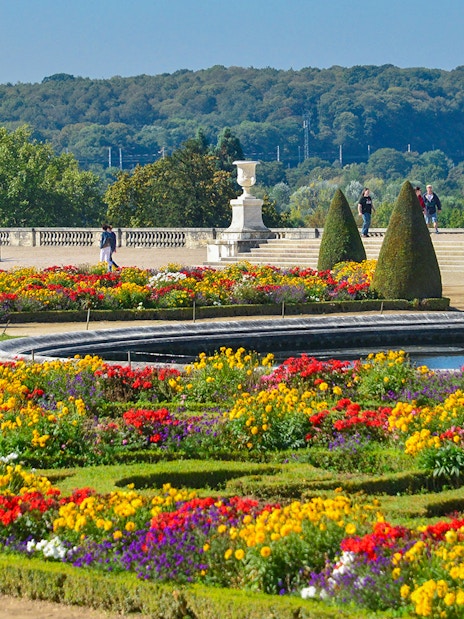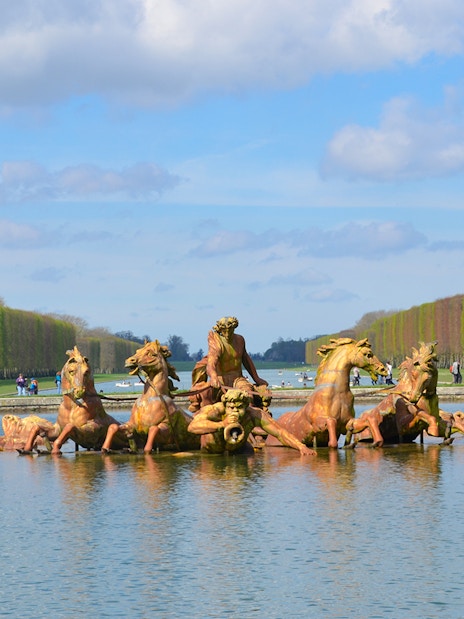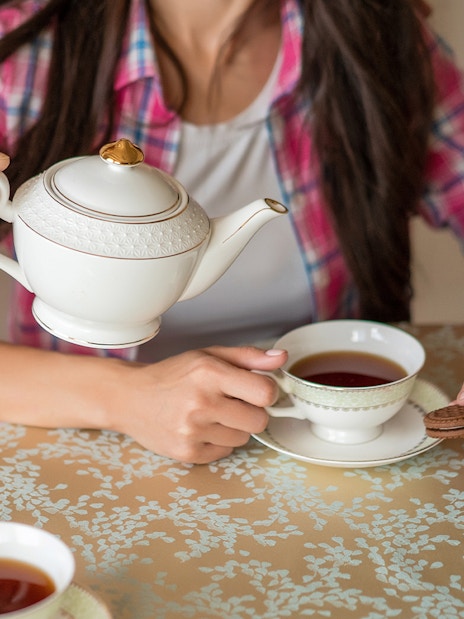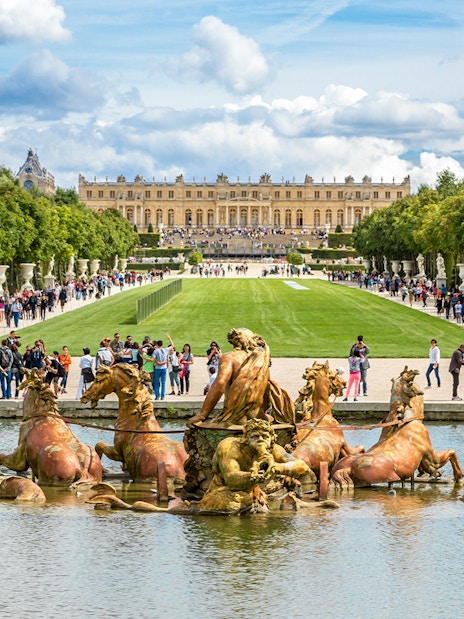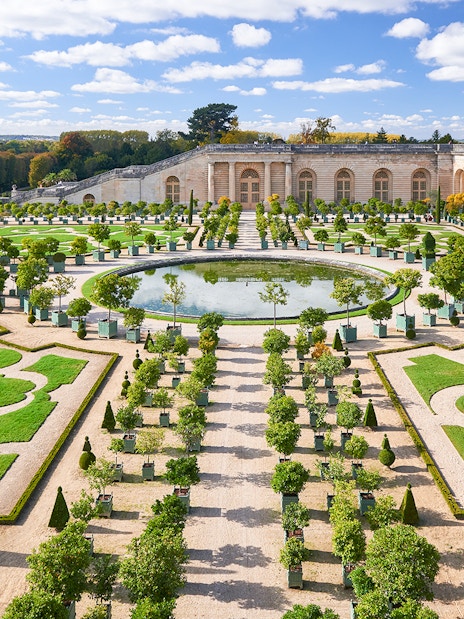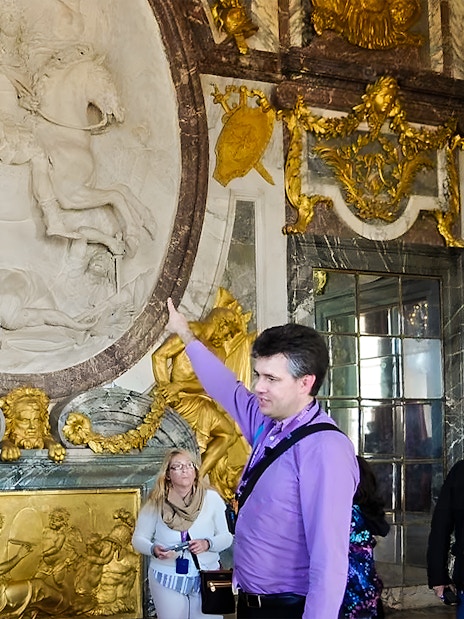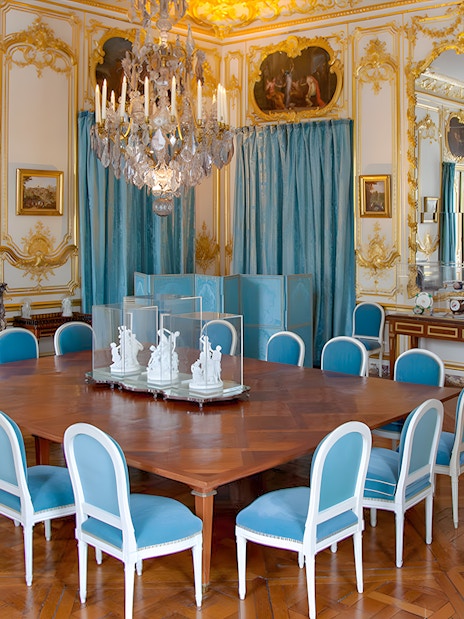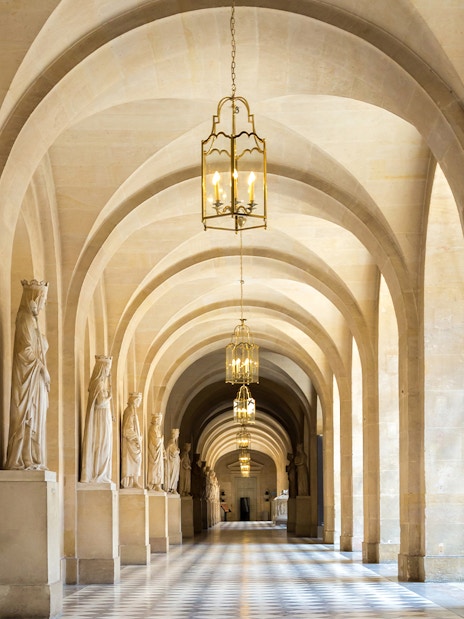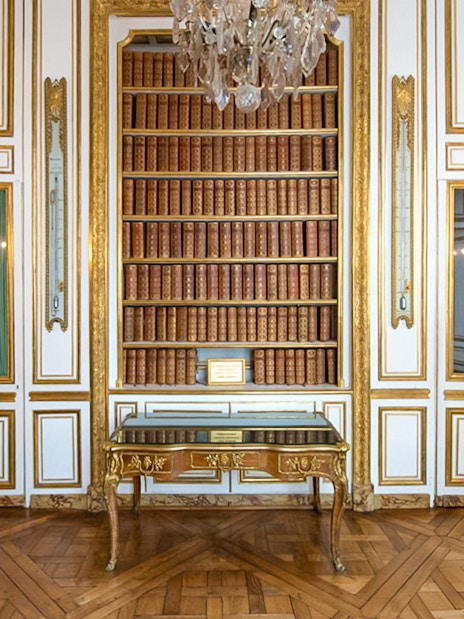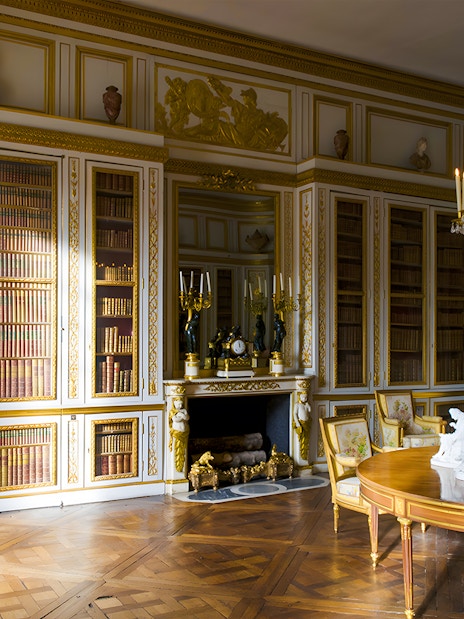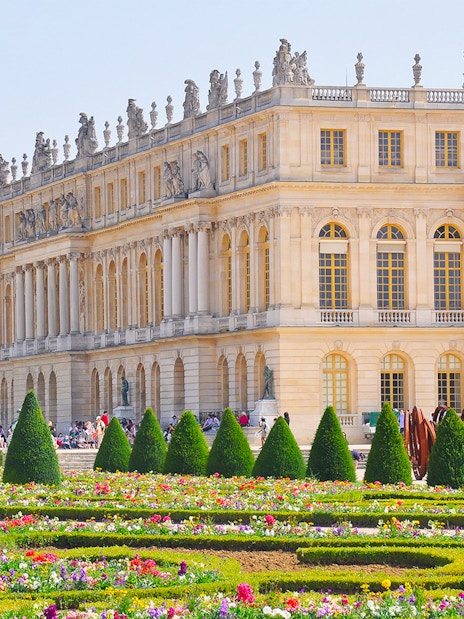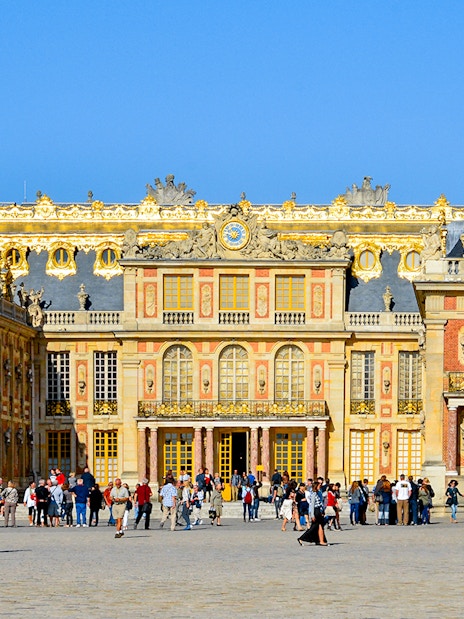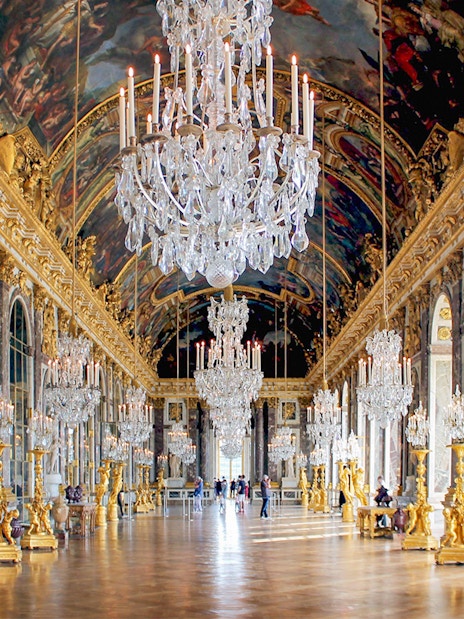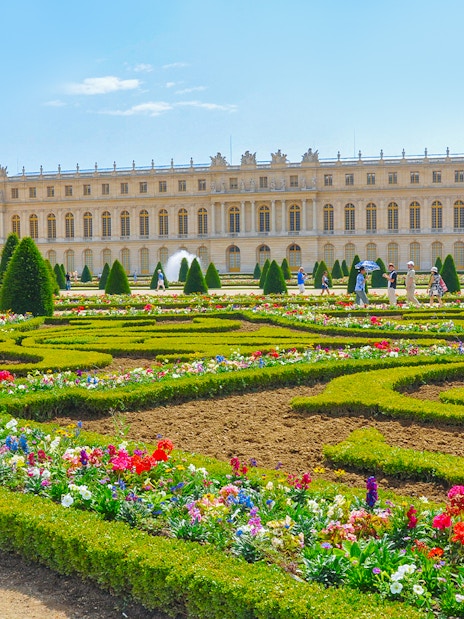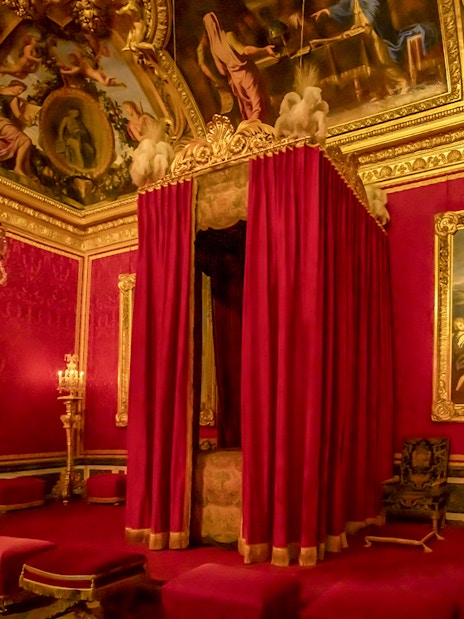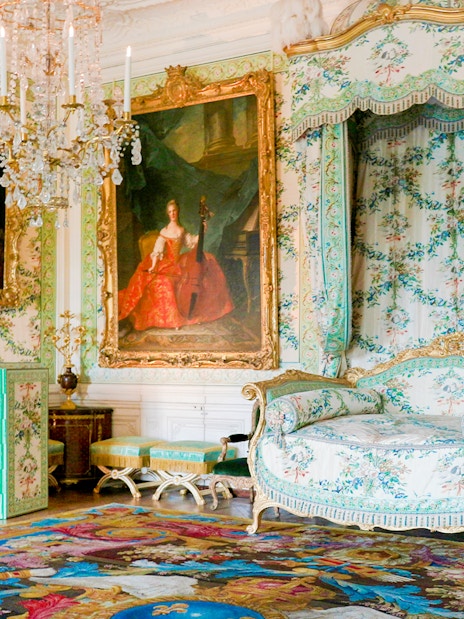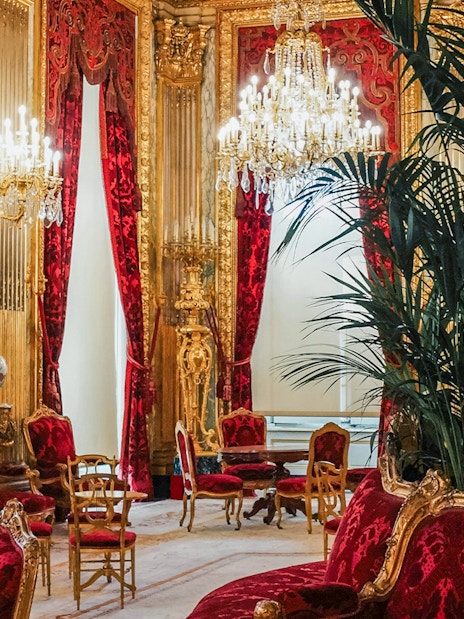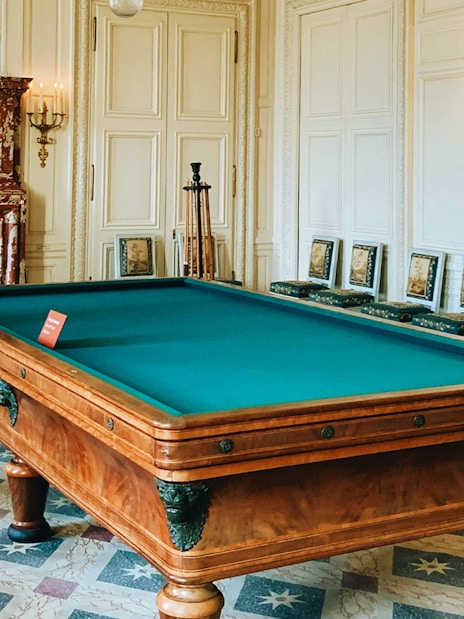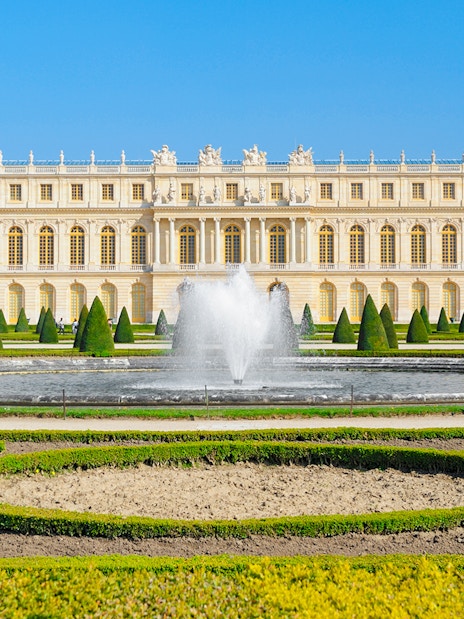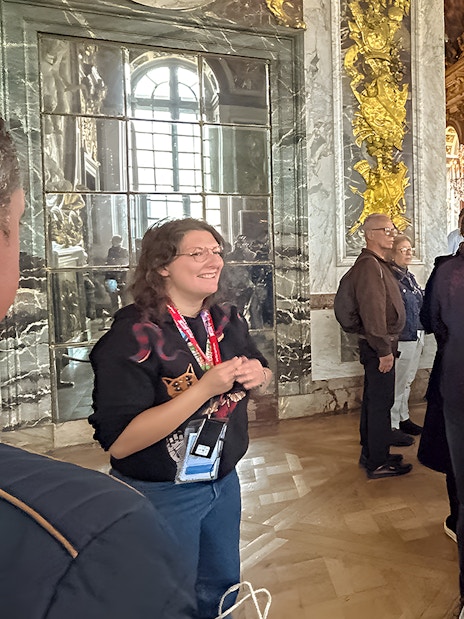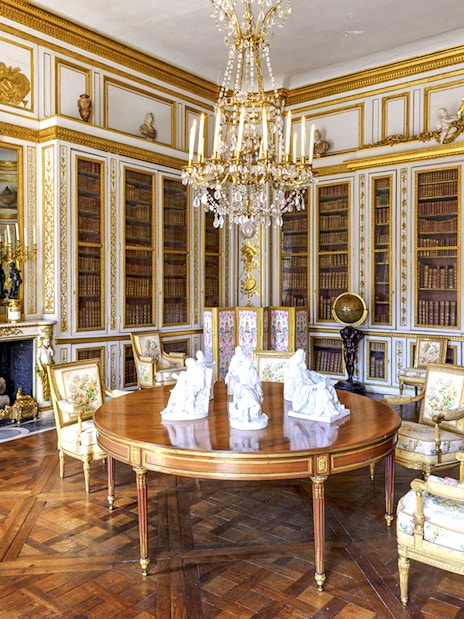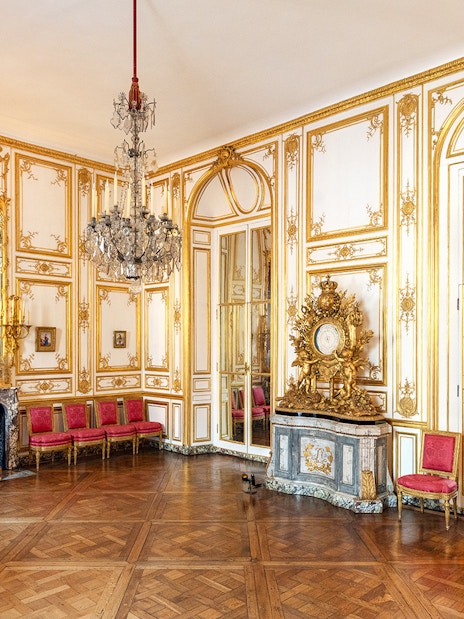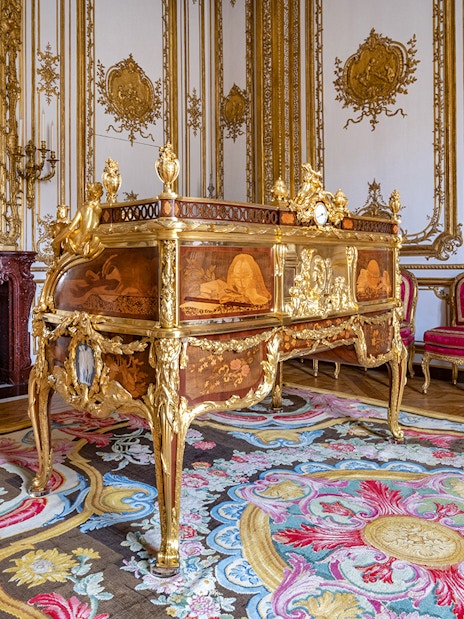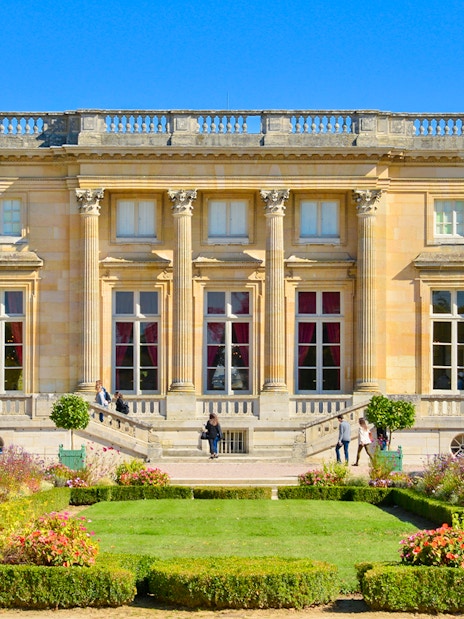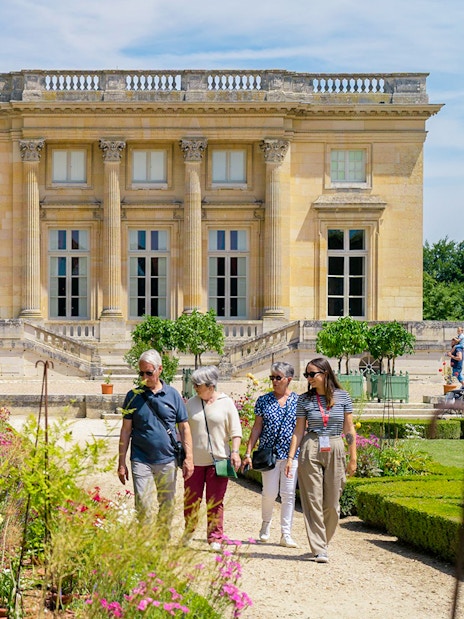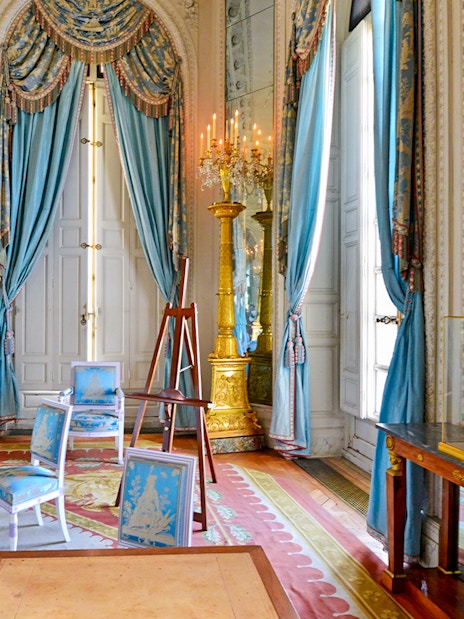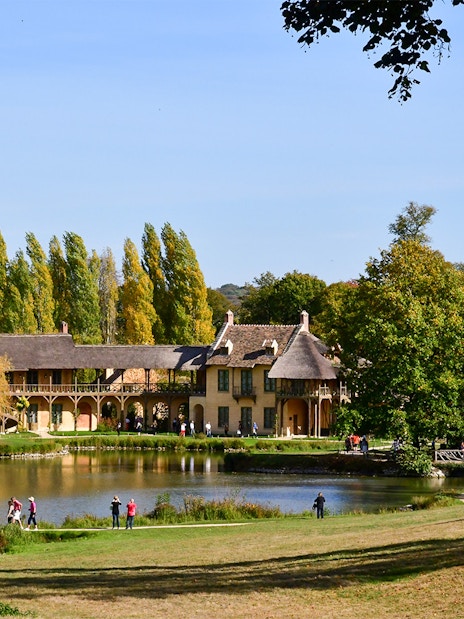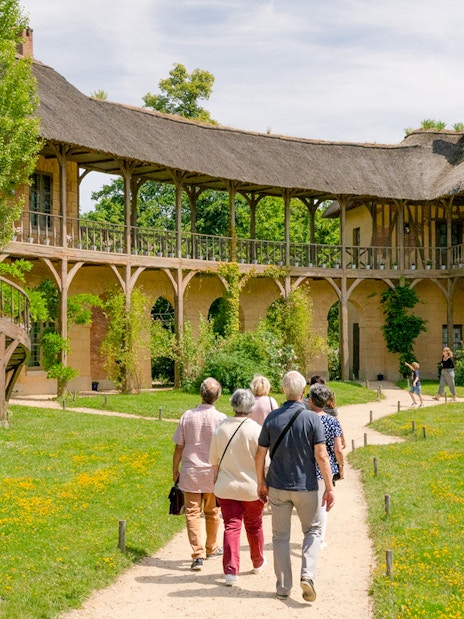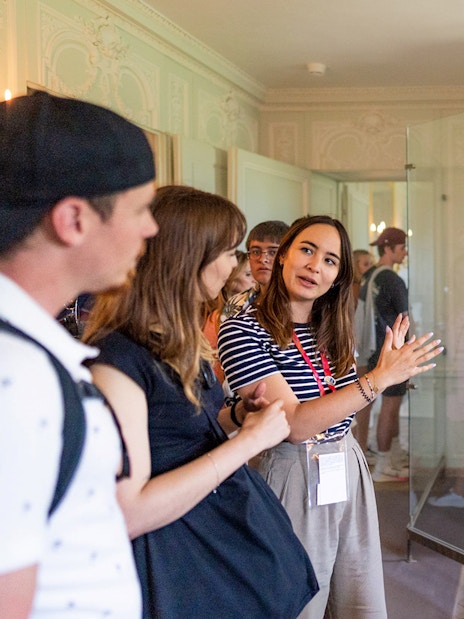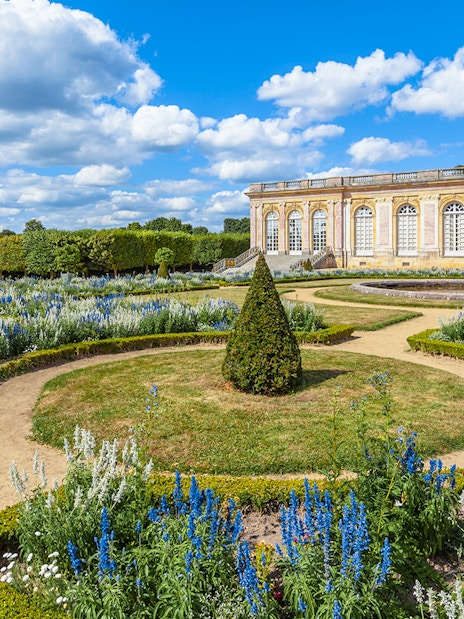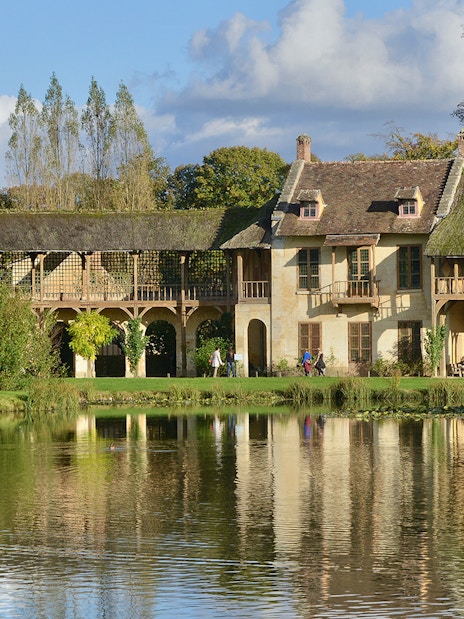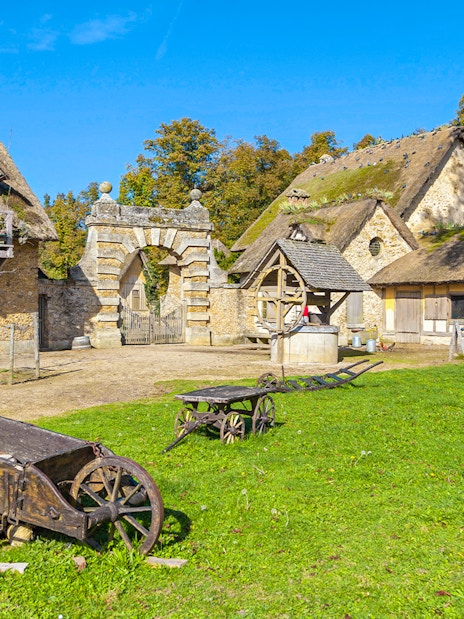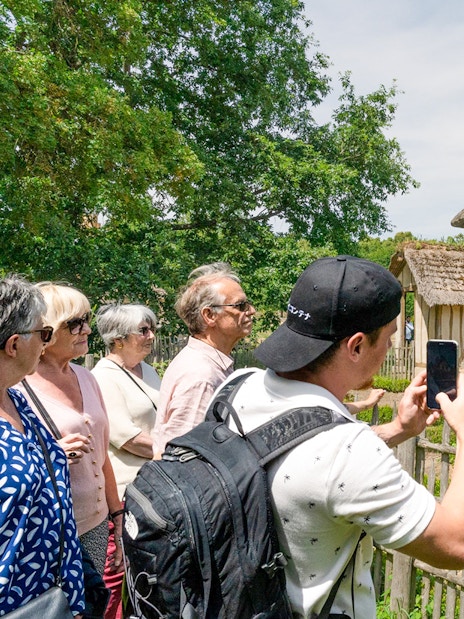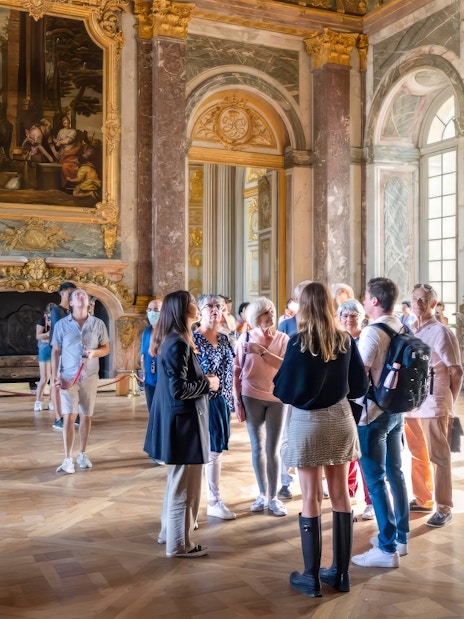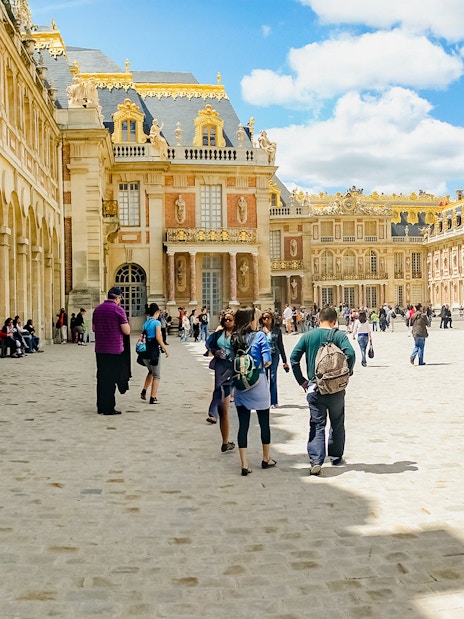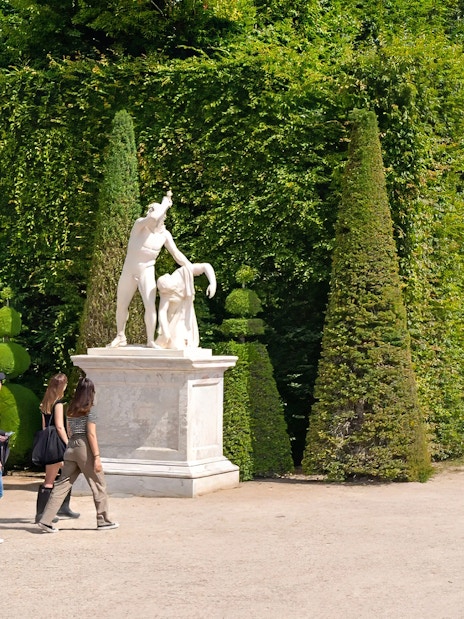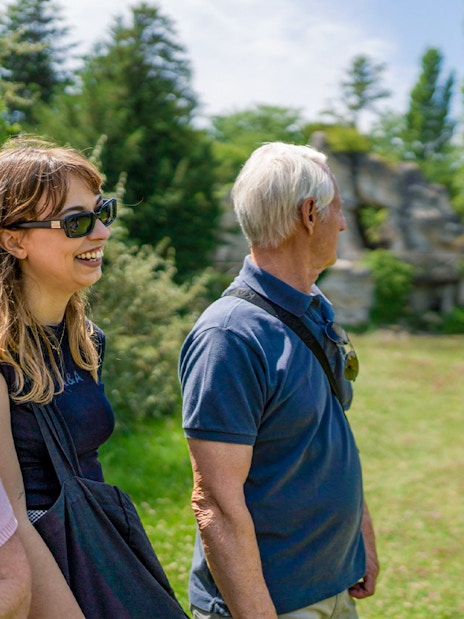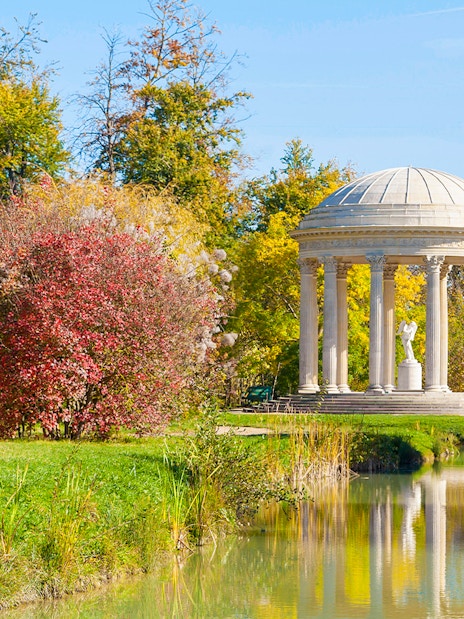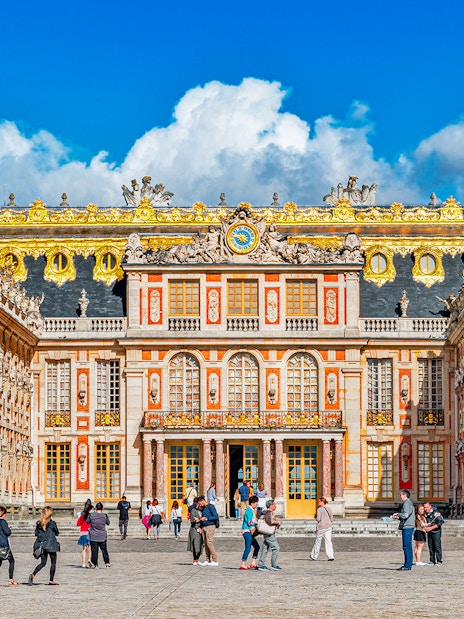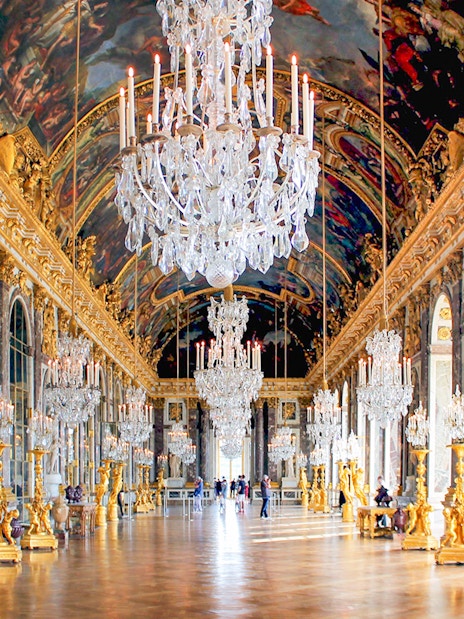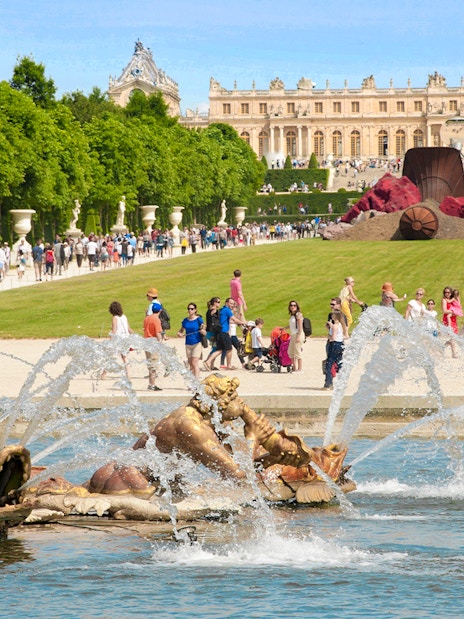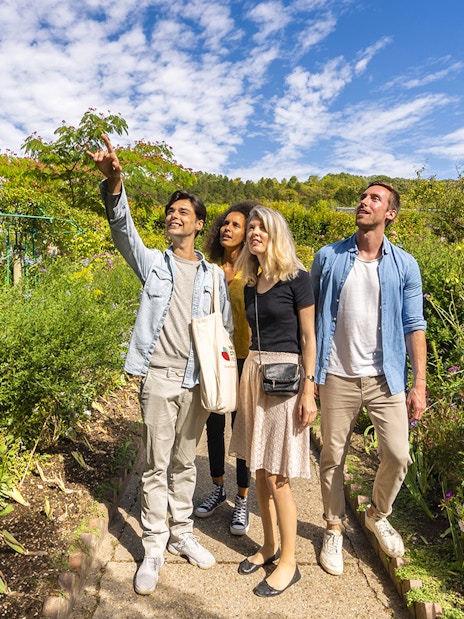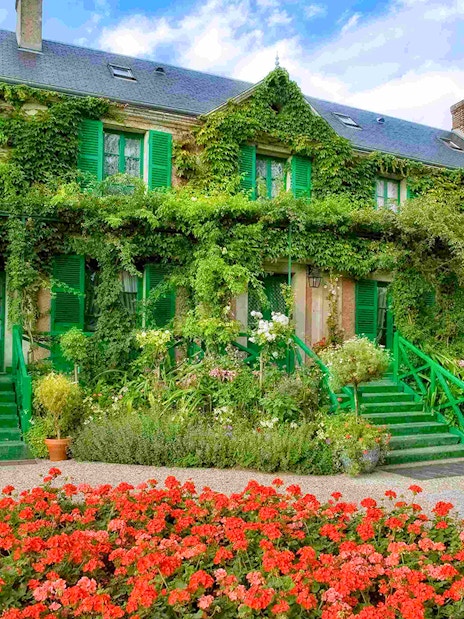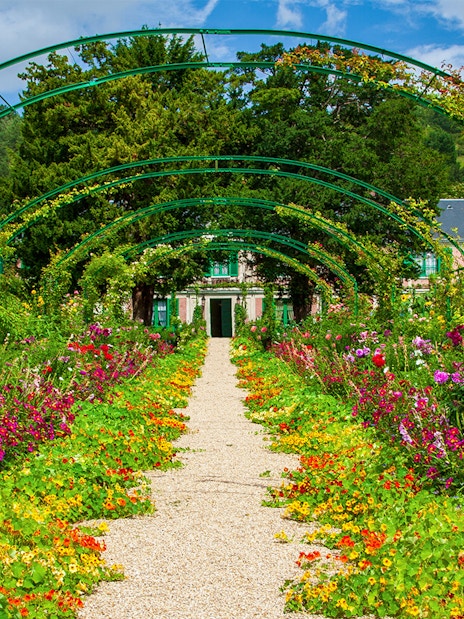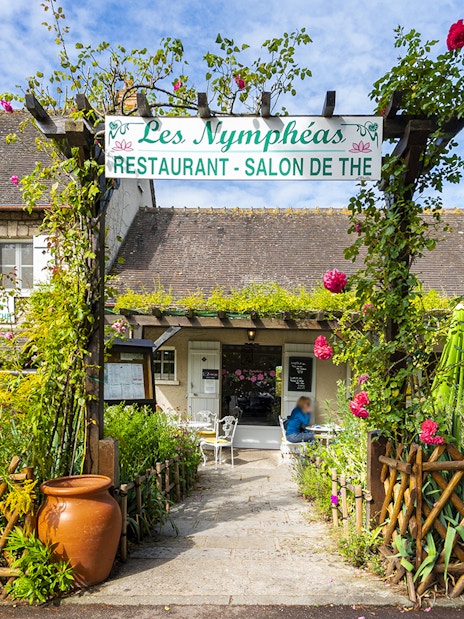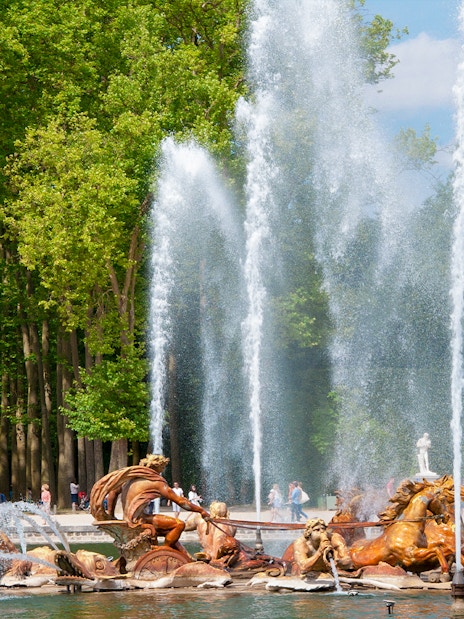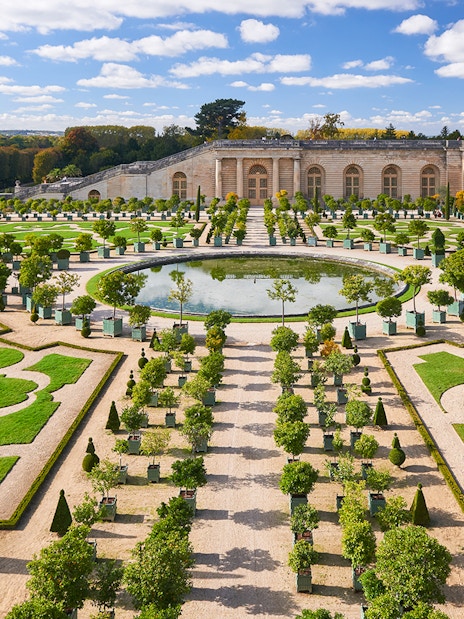- Versailles Palace
- Trianon Estate
- Hall of Mirrors
- History
- Architecture
- Fountains & Gardens
- Day Trips from Paris
- Facts
- Disneyland® Paris Tickets
- Eiffel Tower Tickets
- Louvre Museum Tickets
- Paris Catacombs Tour & Tickets
- Notre-Dame Paris Tickets
- Orsay Museum Tickets
- Paris Pantheon Tickets
- Arc De Triomphe Tickets
- Opera Garnier Paris Tickets
- Centre Pompidou Tickets
- Big Bus Paris Hop-on Hop-off Tours
- Sainte Chapelle Tickets
- Les Invalides Tickets
- Eurail Passes
- Musee de l'Orangerie Tickets
- Rodin Museum Tickets
All about the Versailles Fountains and Gardens

Reserved entry to the Palace at your selected time with the flexibility to explore at your own pace.
- Everything you get: Step into the opulence of Versailles with timed entry to the Palace and explore the lavish Grand King's Apartment, the iconic Hall of Mirrors, and ongoing exhibitions.
- Wander through the vast Versailles Park, and from November to March, enjoy complimentary access to the Gardens.
- Why choose this: A self-paced exploration allows great flexibility in building your itinerary. Spend time on what interests you—history, art, or architecture.
- Upgrades: Extend your experience and explore beyond the main palace by upgrading to a passport ticket, granting access to the Trianon Estate—the royals’ private residences set apart as a retreat from Versailles’ grandeur, offering a glimpse into their lives beyond official duties.
- Visiting between April and October? Catch a fountain or musical show in the Gardens, a stunning choreography of Baroque music and water displays.
Reserved entry to the Palace at your selected time with the flexibility to explore at your own pace.
- Everything you get: Step into the opulence of Versailles with timed entry to the Palace and explore the lavish Grand King's Apartment, the iconic Hall of Mirrors, and ongoing exhibitions.
- Wander through the vast Versailles Park, and from November to March, enjoy complimentary access to the Gardens.
- Why choose this: A self-paced exploration allows great flexibility in building your itinerary. Spend time on what interests you—history, art, or architecture.
- Upgrades: Extend your experience and explore beyond the main palace by upgrading to a passport ticket, granting access to the Trianon Estate—the royals’ private residences set apart as a retreat from Versailles’ grandeur, offering a glimpse into their lives beyond official duties.
- Visiting between April and October? Catch a fountain or musical show in the Gardens, a stunning choreography of Baroque music and water displays.
Inclusions
- Timed entry to the palace
- Access to the Trianon Estate (as per option selected)
- Access to the musical gardens & fountain shows (as per option selected)
- Tea at Ore restaurant (as per option selected)
- Round-trip transfers from Paris (as per option selected)
Exclusions
- Live guide
- Access to the King's Private Apartments
- Re-entry upon leaving the Palace and Garden premises is not allowed.
- Animals are not permitted in the palace, gardens, and Trianon Estate.
- Avoid carrying weapons and sharp objects.
- Valuable items and clothing cannot be deposited in left luggage.
- For information on the Musical Fountains Show and Musical Gardens, click here.
- Left luggage items should be collected at the end of the visit, before 6pm in the high season (April to October) and until 5pm in the low season (November to March).
- These tickets can't be cancelled or rescheduled.
Elevate your Versailles visit with expert-led tours that bring stories to life while ensuring you see all the must-visit highlights.
- Everything you get: Skip-the-ticket-line and enter through a separate entrance with your expert multilingual guide. As you walk through the Palace and its iconic spaces, learn about its history and architecture.
- After, stroll through the French-style gardens designed by André Le Nôtre or the expansive Park featuring the Grand Canal and the Lake of the Swiss Guards.
- Why choose this: A deeper dive into the Versailles Palace's history, architecture, and role in World War I and the French Revolution, brought to life with expert storytelling.
- Upgrades: Explore beyond the main palace by upgrading to a passport ticket, granting access to the Trianon Estate—the royals’ private residences set apart as a retreat from Versailles’ grandeur, offering a glimpse into their lives beyond official duties.
- Visiting between April and October? Catch a fountain or musical show in the Gardens, a stunning choreography of Baroque music and water displays.
- Extend your experience with an exclusive guided tour of the King's Private Apartments, designed for intimate use and accessible only with a guide. Here, Louis XVI welcomed Benjamin Franklin in 1778, and Mozart performed a private concert in 1763.
Elevate your Versailles visit with expert-led tours that bring stories to life while ensuring you see all the must-visit highlights.
- Everything you get: Skip-the-ticket-line and enter through a separate entrance with your expert multilingual guide. As you walk through the Palace and its iconic spaces, learn about its history and architecture.
- After, stroll through the French-style gardens designed by André Le Nôtre or the expansive Park featuring the Grand Canal and the Lake of the Swiss Guards.
- Why choose this: A deeper dive into the Versailles Palace's history, architecture, and role in World War I and the French Revolution, brought to life with expert storytelling.
- Upgrades: Explore beyond the main palace by upgrading to a passport ticket, granting access to the Trianon Estate—the royals’ private residences set apart as a retreat from Versailles’ grandeur, offering a glimpse into their lives beyond official duties.
- Visiting between April and October? Catch a fountain or musical show in the Gardens, a stunning choreography of Baroque music and water displays.
- Extend your experience with an exclusive guided tour of the King's Private Apartments, designed for intimate use and accessible only with a guide. Here, Louis XVI welcomed Benjamin Franklin in 1778, and Mozart performed a private concert in 1763.
Inclusions
- 90-minute guided tour of the palace
- 90-minute guided tour of the estate (as per option selected)
- 90-minute guided tour of the King's private apartment (as per option selected)
- Professional English/French/Italian-speaking guide
- Access to the gardens with the Fountain or Musical show (Apr to Oct only) (as per the option selected)
Exclusions
- Guided tour of the gardens
- Transportation
- Re-entry upon leaving the Palace and Garden premises is not allowed.
- Animals are not permitted in the palace, gardens, and Trianon Estate.
- Avoid carrying weapons and sharp objects.
- Valuable items and clothing cannot be deposited in left luggage.
- For information on the Musical Fountains Show and Musical Gardens, click here.
- Left luggage items should be collected at the end of the visit, before 6pm in the high season (April to October) and until 5pm in the low season (November to March).
- These tickets can't be cancelled or rescheduled.
Combo (Save 5%): Louvre Museum + Versailles Palace Tickets
5% off
One ticket, two iconic sites—unlock a special discount to explore France's iconic museum and royal legacy.
- Everything you get: Save up to 2 hours of waiting at both, the Louvre Museum and the Versailles Palace, with timed entry tickets.
- At the Louvre, access Musée Eugène-Delacroix which houses his masterpiece, Liberty Leading the People, and the remaining 35,000 pieces including the Mona Lisa. To help you navigate the vastness, a multilingual audio guide is available with your ticket.
- At the Versailles Palace, gain access to the entire estate—Palace, Trianon Estate, and shows at the Gardens, with your passport ticket.
- Wander through the iconic Hall of Mirrors in the Palace; explore the royals' retreat homes at the Trianon Estate to see how royals lived beyond their official duties; and if you're visiting between April and October, enjoy a mesmerizing fountain show set to Baroque music set in the Gardens.
- Why choose this: Experience the hearts of French art and architecture in one combo. Avoid the hassle of multiple bookings and long wait lines with reserved access to both landmarks.
One ticket, two iconic sites—unlock a special discount to explore France's iconic museum and royal legacy.
- Everything you get: Save up to 2 hours of waiting at both, the Louvre Museum and the Versailles Palace, with timed entry tickets.
- At the Louvre, access Musée Eugène-Delacroix which houses his masterpiece, Liberty Leading the People, and the remaining 35,000 pieces including the Mona Lisa. To help you navigate the vastness, a multilingual audio guide is available with your ticket.
- At the Versailles Palace, gain access to the entire estate—Palace, Trianon Estate, and shows at the Gardens, with your passport ticket.
- Wander through the iconic Hall of Mirrors in the Palace; explore the royals' retreat homes at the Trianon Estate to see how royals lived beyond their official duties; and if you're visiting between April and October, enjoy a mesmerizing fountain show set to Baroque music set in the Gardens.
- Why choose this: Experience the hearts of French art and architecture in one combo. Avoid the hassle of multiple bookings and long wait lines with reserved access to both landmarks.
Inclusions
Louvre Museum
- Reserved access entry ticket
- Access to temporary exhibitions
- Free admission to the Musée Eugène-Delacroix
- Audio guide available in English, Spanish, French, German, Italian, Portuguese, Polish & Japanese
Palace of Versailles
- Passport ticket (access to the palace + estate + garden shows)
- Entry to the temporary exhibitions
Louvre Museum
- There is no priority access to the temporary exhibitions inside the Louvre. If you miss your scheduled time slot, you must join the line for regular ticket holders.
- The visit routes will be signposted, with no possible backtracking to avoid crossing flows. Additionally, re-entry is not allowed after you leave the venue.
- The venue is wheelchair and pram/stroller accessible.
- Entry to the venue will be free on July 14 owing to Independence Day in France.
- Please note that printed tickets are required to enter the venue.
Versailles Palace
- Re-entry upon leaving the Palace and Garden premises is not allowed.
- Animals are not permitted in the palace, gardens, and Trianon Estate.
- Avoid carrying weapons and sharp objects.
- Valuable items and clothing cannot be deposited in left luggage.
- For information on the Musical Fountains Show and Musical Gardens, click here.
- Left luggage items should be collected at the end of the visit, before 6pm in the high season (April to October) and until 5pm in the low season (November to March).
- These tickets can't be cancelled or rescheduled.
Easy transfers from Paris & explore Versailles your way—self or guided.
- Everything you get: Travel comfortably in an air-conditioned coach from Paris to Versailles and enter the Palace with timed entry tickets.
- Explore the grandeur of Versailles—from the iconic Hall of Mirrors to the lavish Grand King's Apartment, and ongoing exhibitions.
- Enjoy complimentary access to the French formal Gardens between November and March, and wander through the sprawling verdant Park—perfect for a picnic.
- Why choose this: Skip planning the travel logistics and only focus on crafting the perfect itinerary!
- Upgrades: Enhance your visit with a guided tour of the Palace, covering key sights with expert insights.
- Choose a small group tour (15 guests) for a more intimate, interactive experience.
Easy transfers from Paris & explore Versailles your way—self or guided.
- Everything you get: Travel comfortably in an air-conditioned coach from Paris to Versailles and enter the Palace with timed entry tickets.
- Explore the grandeur of Versailles—from the iconic Hall of Mirrors to the lavish Grand King's Apartment, and ongoing exhibitions.
- Enjoy complimentary access to the French formal Gardens between November and March, and wander through the sprawling verdant Park—perfect for a picnic.
- Why choose this: Skip planning the travel logistics and only focus on crafting the perfect itinerary!
- Upgrades: Enhance your visit with a guided tour of the Palace, covering key sights with expert insights.
- Choose a small group tour (15 guests) for a more intimate, interactive experience.
Inclusions
- Skip-the-line entry to the palace
- Round-trip bus transfers from the Eiffel Tower
- English-speaking professional guide (as per option selected)
- Access to the entire estate (as per option selected)
- Small-group guided tour (as per option selected)
- Re-entry upon leaving the Palace and Garden premises is not allowed.
- Animals are not permitted in the palace, gardens, and Trianon Estate.
- Avoid carrying weapons and sharp objects.
- Valuable items and clothing cannot be deposited in left luggage.
- For information on the Musical Fountains Show and Musical Gardens, click here.
- Left luggage items should be collected at the end of the visit, before 6pm in the high season (April to October) and until 5pm in the low season (November to March).
- You can cancel these tickets up to 72 hours before the experience begins and get a full refund.
Guided Tour of the King's Private Apartments with Palace of Versailles Skip-the-Line Tickets
Elevate your estate visit with exclusive access to the private chambers of Louis XVI and Marie Antoinette.
- Everything you get: Led by a multilingual expert guide, step inside the otherwise restricted King's Private Apartments, an intimate space featuring a suite of rooms belonging to the last two kings of Versailles. Depending on the tour day, you can either visit the Royal Chapel or the Royal Opera (decided by your guide), each a grand construction from the early 18th-century.
- Post the tour, enjoy a self-guided visit of the estate, covering the Palace, Trianon Estate, and the Gardens. If you're visiting between April and October, catch a musical/fountain show in Gardens—a one-off experience where water fountains dance to Baroque music.
- Why choose this: Most tours don't include access to the King's Private Apartments—this one does. Step beyond the grand halls for a rare look at royal life behind closed doors.
Elevate your estate visit with exclusive access to the private chambers of Louis XVI and Marie Antoinette.
- Everything you get: Led by a multilingual expert guide, step inside the otherwise restricted King's Private Apartments, an intimate space featuring a suite of rooms belonging to the last two kings of Versailles. Depending on the tour day, you can either visit the Royal Chapel or the Royal Opera (decided by your guide), each a grand construction from the early 18th-century.
- Post the tour, enjoy a self-guided visit of the estate, covering the Palace, Trianon Estate, and the Gardens. If you're visiting between April and October, catch a musical/fountain show in Gardens—a one-off experience where water fountains dance to Baroque music.
- Why choose this: Most tours don't include access to the King's Private Apartments—this one does. Step beyond the grand halls for a rare look at royal life behind closed doors.
Inclusions
- Skip-the-line passport tickets
- \90-minute guided tour of the King's private apartment
- Official Versaille multilingual guide
- Exclusive access to either the Royal Opera or Royal Chapel
- Small group tour of 20 or less
Exclusions
- Guided tour of the Versailles Palace
- Entry to the Royal Chapel or Royal Opera is at the guide's discretion.
- Re-entry upon leaving the Palace and Garden premises is not allowed.
- Animals are not permitted in the palace, gardens, and Trianon Estate.
- Avoid carrying weapons and sharp objects.
- Valuable items and clothing cannot be deposited in left luggage.
- For information on the Musical Fountains Show and Musical Gardens, click here.
- Left luggage items should be collected at the end of the visit, before 6pm in the high season (April to October) and until 5pm in the low season (November to March).
- These tickets can't be cancelled or rescheduled.
Get priority access to explore Versailles’ private royal retreats, beyond the Palace.
- Everything you get: Skip the wait with priority access tickets and follow the audio guide/interactive map on the official Versailles app, Chateau de Versailles, to explore the Grand Trianon, Petit Trianon, the Queen's Hamlet, and the gardens.
- Why choose this: Visiting the Trianon Estate reveals the royals’ private world beyond their official duties—their daily lives, personal interests, and leisure spaces like the billiards room, games room, and farm.
Get priority access to explore Versailles’ private royal retreats, beyond the Palace.
- Everything you get: Skip the wait with priority access tickets and follow the audio guide/interactive map on the official Versailles app, Chateau de Versailles, to explore the Grand Trianon, Petit Trianon, the Queen's Hamlet, and the gardens.
- Why choose this: Visiting the Trianon Estate reveals the royals’ private world beyond their official duties—their daily lives, personal interests, and leisure spaces like the billiards room, games room, and farm.
Inclusions
- Skip-the-line tickets to the Trianon Estate, after noon
- Temporary exhibitions held in the Grand Trianon
- The Coach Gallery, from 12:30pm
Exclusions
- Access to the Versailles Palace
- Shows at the Palace's garden
- Animals are not permitted in the palace, gardens, and Trianon Estate.
- Avoid carrying weapons and sharp objects.
- From July 2 to September 8, early opening at 10am.
- You may experience some waiting time at the security check at the entrance of the Estate
- Pick up an Estate of Trianon leaflet for free at the entrance.
- To make the most of your visit—the Gardens are open from 8am, the Estate of Trianon from noon, the Gallery of Coaches and The Royal Tennis Court at 12:30pm.
- Valuable items and clothing cannot be deposited in left luggage.
- Left luggage items should be collected at the end of the visit, before 6pm in the high season (April to October) and until 5pm in the low season (November to March).
- These tickets can't be cancelled or rescheduled.
Full Day From Paris: Palace of Versailles Guided Tour with Access to Queen Marie Antoinette's Estate
Step into Marie-Antoinette's fairytale world of rustic cottages and luxuriant gardens.
- Everything you get: Skip the ticket line and step into the grand Versailles Palace for an expert-led guided tour; listen to stories of what makes the Hall of Mirrors iconic beyond its interiors and how Versailles lost its seat of power during the French Revolution.
- Head towards the Queen's quarters for a guided tour of the Petit Trianon, Queen's Hamlet and the surrounding ornamental gardens. These spaces were the queen's getaway, built to her liking—rural architecture, a fully functional farm with a lake.
- Post the tour, board the Petit Train back to the Palace; it saves you a 30-minute walk to the Palace.
- Why choose this: A closer look at Marie Antoinette’s life—her pursuit of a simple life despite being the Queen of France.
Step into Marie-Antoinette's fairytale world of rustic cottages and luxuriant gardens.
- Everything you get: Skip the ticket line and step into the grand Versailles Palace for an expert-led guided tour; listen to stories of what makes the Hall of Mirrors iconic beyond its interiors and how Versailles lost its seat of power during the French Revolution.
- Head towards the Queen's quarters for a guided tour of the Petit Trianon, Queen's Hamlet and the surrounding ornamental gardens. These spaces were the queen's getaway, built to her liking—rural architecture, a fully functional farm with a lake.
- Post the tour, board the Petit Train back to the Palace; it saves you a 30-minute walk to the Palace.
- Why choose this: A closer look at Marie Antoinette’s life—her pursuit of a simple life despite being the Queen of France.
Inclusions
- Timed entry tickets to the Palace
- Expert English-speaking guide
- Round-trip transfers from central Paris
- Access to the Gardens during the fountain and musical shows
- Access to the queen's estate
- One-way ticket to the Petit train
Exclusions
- Hotel pick up and drop-off
- Re-entry upon leaving the Palace and Garden premises is not allowed.
- Animals are not permitted in the palace, gardens, and Trianon Estate.
- Avoid carrying weapons and sharp objects.
- Valuable items and clothing cannot be deposited in left luggage.
- For information on the Musical Fountains Show and Musical Gardens, click here.
- Left luggage items should be collected at the end of the visit, before 6pm in the high season (April to October) and until 5pm in the low season (November to March).
- You can cancel these tickets up to 72 hours before the experience begins and get a full refund.
One ticket, 2 iconic sites—explore the architecture of Versailles and the art of Giverny Gardens.
- Everything you get: Tour Monet's Gardens in Giverny, which served as the artist's primary source of inspiration, particularly his iconic Water Lilies series.
- Explore his studio and pink-plastered house (reconstructed with original furniture) on your own before boarding the bus to Versailles.
- Step into the opulence of Versailles with your timed entry tickets, allowing you to skip the ticket line. Follow your guide through the iconic Hall of Mirrors and the lavish Grand Apartments as legendary stories come to life. Wander through the vast Versailles Park, and from November to March, enjoy complimentary access to the Gardens.
- Round-trip transfers from Paris allows for a seamless experience.
- Why choose this:
- Experience the grandeur of Versailles and the charm of Monet's Giverny Gardens in one combo. Skip the hassle of multiple bookings while enjoying expert storytelling that brings royal history and artistic inspiration to life.
- Upgrades: Choose a small group tour (of 8 or less) to gain more personal time with your guide so you can explore at a relaxed pace. With a full-day itinerary, adding a 3-course French lunch—available with both group sizes—means you’re well-fed and don’t have to worry about finding food between stops.
One ticket, 2 iconic sites—explore the architecture of Versailles and the art of Giverny Gardens.
- Everything you get: Tour Monet's Gardens in Giverny, which served as the artist's primary source of inspiration, particularly his iconic Water Lilies series.
- Explore his studio and pink-plastered house (reconstructed with original furniture) on your own before boarding the bus to Versailles.
- Step into the opulence of Versailles with your timed entry tickets, allowing you to skip the ticket line. Follow your guide through the iconic Hall of Mirrors and the lavish Grand Apartments as legendary stories come to life. Wander through the vast Versailles Park, and from November to March, enjoy complimentary access to the Gardens.
- Round-trip transfers from Paris allows for a seamless experience.
- Why choose this:
- Experience the grandeur of Versailles and the charm of Monet's Giverny Gardens in one combo. Skip the hassle of multiple bookings while enjoying expert storytelling that brings royal history and artistic inspiration to life.
- Upgrades: Choose a small group tour (of 8 or less) to gain more personal time with your guide so you can explore at a relaxed pace. With a full-day itinerary, adding a 3-course French lunch—available with both group sizes—means you’re well-fed and don’t have to worry about finding food between stops.
Inclusions
- Full-day tour of Giverny Gardens & Versailles Palace
- Roundtrip transfers in an AC coach from Paris
- Expert-English speaking guide
- Priority access to Monet's house & gardens
- 3-course lunch, drinks included (as per the option selected) (check menu here)
- Skip-the-line entry to the Palace of Versailles and its gardens
- Access to the gardens with the Fountain or Musical show (Apr to Oct only) (as per the option selected)
- Small group of 8/15 (as per the option selected)
Exclusions
- Guided tour inside Monet's house
- Animals are not permitted in the palace, gardens, and Trianon Estate.
- Avoid carrying weapons and sharp objects.
- From July 2 to September 8, early opening at 10am.
- You may experience some waiting time at the security check at the entrance of the Estate
- Pick up an Estate of Trianon leaflet for free at the entrance.
- To make the most of your visit—the Gardens are open from 8am, the Estate of Trianon from noon, the Gallery of Coaches and The Royal Tennis Court at 12:30pm.
- Valuable items and clothing cannot be deposited in left luggage.
- Left luggage items should be collected at the end of the visit, before 6pm in the high season (April to October) and until 5pm in the low season (November to March).
- You can cancel these tickets up to 24 hours before the experience begins and get a full refund.
Top things to do in Paris
The Gardens at Palace of Versailles
The Gardens of Versailles, sprawling across 250 acres, are a testament to French formal gardening and a must-see for any visitor to the Palace of Versailles. Designed by the landscape architect André Le Nôtre, these meticulously planned gardens blend nature with art, creating a breathtaking visual experience.
André Le Nôtre's architectural vision
Le Nôtre, appointed by King Louis XIV, envisioned the gardens as an extension of the palace itself. He used a symmetrical layout with central axes radiating outwards, emphasizing perspective and grandeur. The gardens were designed to be viewed from the palace windows, offering a sense of order and control over nature.
The King's Garden (Jardin du Roi)
This private garden, located near the Orangery, was designed specifically for King Louis XIV's enjoyment. Enclosed by walls and featuring a more intimate layout, it offered the king a tranquil escape from the grandeur of the main gardens. Here, he could relax, tend to his own plants, and enjoy a more personal connection with nature.
The Water Theater (Théâtre d'Eau)
This unique feature, located at the western end of the main garden, is a marvel of engineering and artistry. Composed of cascading pools, fountains, and sculptures that come alive with water displays synchronized to music, the Water Theater offers a captivating spectacle and a fitting finale to a walk through the gardens.
The Orangery
This impressive building, located on the south side of the palace, served as a winter home for the palace's orange trees. The Orangery's grand architecture, with its high ceilings and large windows, provided the ideal environment for these delicate trees to flourish during the colder months. Today, the Orangery houses exhibitions and cultural events.
Explore the fountains at Palace of Versailles
The Four Seasons fountains
The monumental Four Fountains, dedicated to the seasons, mark the entrance to the Royal Way. The Spring and Summer Fountains grace the northern side of the alleys, while Autumn and Winter adorn the south.
Fountains of the Fight of the Animals
The fountain demonstrates a fight between animals. A lion is shown defeating a wolf and wild boar, a tiger defeating a bear and a bloodhound bringing down a stag. Water jets sprout out of the animal's mouths, with the jet of the victorious animal falling into the upper basin and the jet of the victim falls into the lower basin.
Dragon fountain
A majestic piece of art, the Dragon Fountain represents an episode from the legend of Apollo, where young Apollo shot and killed a serpent Python with an arrow. This is the tallest fountain in the Gardens of Versailles, with the main water jet reaching a height of 27 meters.
Neptune fountain
Made between 1679 and 1682, the construction of the Neptune Fountain was overseen by André le Nôtre and officially opened by Louis XV. Admired for its size, the fountain is also an extraordinary hydraulic system featuring 99 jets.
Latona's fountain
Illustrating the story of Apollo's mother Latona, the fountain depicts her protecting her children from the insults of peasants and pleading with the gods to avenge her. The gods oblige and turn the peasants into frogs and lizards. The fountain features figures of peasants in mid-transformation with 24 frogs surrounding the fountain.
Apollo's fountain
Built between 1668 and 1670, the fountain is based on the legend of Apollo, the sun god. Designed by Charles Le Brun, It features Apollo rising from the sea on a four-horse chariot, surrounded by tritons and leaping dolphins.
Frequently asked questions about Palace of Versailles Fountains and Gardens
The gardens are open to the public every day of the year.
Yes, tickets for the Palace and the Gardens are separate. Standard admission tickets do not include access to the gardens and fountains. However, with the Passport ticket, you will be able to visit the entire estate, including the palace, the gardens, and the fountain shows.
The Versailles Passport ticket is a ticket variant that gives you access to all of the estate. With the Versailles Passport, you will be able to visit the Palace with audioguide, the estate of Trianon, temporary exhibitions, the Gardens and the Park, the Musical Fountains Shows or the Musical Gardens and the Coach Gallery.
You can purchase tickets to the Palace of Versailles up to 3 months in advance.
Yes, picnics are permitted only in the designated area near the Water Walk, located in the Marmousets Hall. This area also provides convenient restroom facilities.
Yes, you can refer to the interactive guide "Bienvenue" to help you explore the palace and estate at your own pace.

